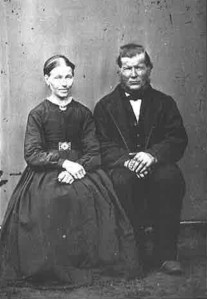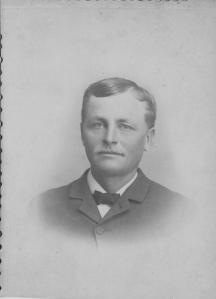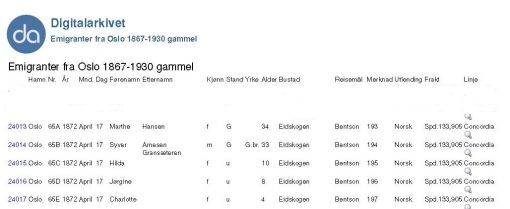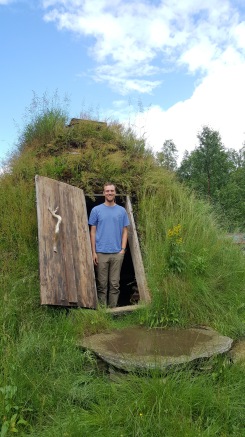Earlier we have related that Hans and Margrete had siblings in USA. Hans had two brothers, Anders b. 1836 and Lars Jorgen, b. 1838, and two sisters, Dina, b. 1826 and Rakel, b. 1834. The story about Anders and Lars Jorgen was published earlier on this site.  Rakel was married twice, first with Isak Tomassen, Skonseng and later with Kristian Henriksen, Eiteråga. In 1880, Rakel and Kristian and seven children traveled to America. So far the story of Rakel. Maybe we will return with more later.
Rakel was married twice, first with Isak Tomassen, Skonseng and later with Kristian Henriksen, Eiteråga. In 1880, Rakel and Kristian and seven children traveled to America. So far the story of Rakel. Maybe we will return with more later.
Rakel Olsdtr. and Kristian Henriksen with their family in Trondheim on their way to America. (Photo from Vranna Manor)
Nor have we heard so much about Dina. However, last summer we received a message from Amy K. Brown, living in Texas. She is a descendant of Dina and made inquiry about Dina and her family, as well as the family in Norway and wanted to know as much as possible. She also wondered about a part in a letter left after Dina’s brother, Lars Jorgen. Dina and her daughter, Milda, traveled to America in 1883 together with her brother and his family. During this trip Lars Jorgen wrote a long letter to his brother, Mathias, who lived at Bjollanes. This letter has been saved by Mathias’ descendants and it is published as a part of Lars Jorgen and Anna’s family story. Among other he writes this:
“Tell E. Larsen that Dina and Milda are getting along well, and give him our hearty greeting. Also, tell those who criticize me regarding my sister and think I have done too much for her, they can mind their own business and not concern themselves so much about me or her. However, enough about this.”
It was this part of the letter Amy Brown wondered about. Elias Larsen was Dina’s husband. Why was he left behind? Why did she leave? What could he mean by having done “too much for her”?

Dina & Elias (Photo: O.T. Olsen)
We have tried to find answers to these questions and it was naturally to go to the “nestor” in the Bjollanes family, Kare Bjellanes and he is revealing the following:
“Dina’s departure and emigration to America is a dark spot in the family story. She just left her husband and went.”
A possible reason might be a disagreement between her and Elias about who would take over the farm; Lars Kristian, Elias’ son from his first marriage, or their mutual son, Ole Tobias. According to tradition, Dina had made Elias promise her that if they got a son together, he would take over the farm. Elias chose to leave the farm to Lars Kristian. This was alleged to be the reason for the break. Lars Jorgen is said to have supported Dina in this case, so the comment in the letter might be the connection to this affair. Most of the people at Bjollanes seem to have supported Elias and perhaps criticized Lars Jorgen because they felt he had done too much for Dina.
In any case, in 1883 Dina and Milda were on their way to America. Her son, Ole Tobias, had left for America the year before.
Dina was born in 1826. She married Hans Olai Steen in Beiarn in 1848. Two of her brothers had already established themselves there. Hans and Dina had a son in 1850, but during that year both her husband and son died. Dina left Beiarn and moved back to her home farm at Bjollanes. The neighbor was Elias Larsen and his wife, Dortea Olsdtr. b. 1812. She was Dina’s half sister. Dortea died in 1851 and Elias was left with a 7 year old son. To make a long story short, Elias and Dina married in 1852 and then Dina had made Elias promise that their son would inherit the farm.
The farmers at Bjollanes were tenants. They didn’t own the land, but leased it. The rental contract could be passed on as an inheritance, but not necessarily to the oldest son. Usually the oldest son had a special right, allodial privilege, which gave him the right to take over the ownership of a farm after the parents, but not the tenancy. It was the land owner who decided, however, he did often take advice from the former tenant. Therefore, it could happen that a younger son could take over the farm, or tenant contract, as Dina had demanded in case she and Elias had a son together.

Dina and Elias’ home. (Photo from Vranna Manor)
There were four farms at Bjollanes in 1875, a few years before Dina left; one of them belonged to Elias Larsen and Dina. If we look back in history of this farm, we can find that Elias and Dortea married in 1841. Dortea had already been married to Ola Jenssen. They were married in 1829 and had three daughters; Ola died in 1840. Before the marriage with Dortea, Ola Jenssen was married to Marit Eliasdtr, they had three sons and one daughter. There were therefore many who saw a possibility to take over the farm after Elias and Dina.
This might seem confusing to us today. However, life expectancy was not as high as it is today. When a man or wife died and left small children, the survivor had to find a new spouse as fast as possible. Marit died in 1834 and Ola Jenssen married the same year with Dortea Olsdtr. When Ola died, Dortea married Elias Larsen the next year. As before mentioned, Dortea died in 1851, and Elias and Dina married in 1852.
How could Elias promise Dina that one of their sons would take over the farm under these circumstances? Whatever the reason was, it was quite frivolous of Elias. Perhaps it was as we say that “love is blind” and that he promised anything to marry Dina. We don’t know for sure, but it is likely that Elias did make the promise.
The value of this promise came under pressure already in 1864 when the farm was divided in half. Elias Olsen, the son of Ola Jenssen and Marit Eliasdtr. took over one half. We don’t know the circumstances of this division, but we get a feeling that the elder son had an ethical claim to assume ownership to this part of the farm. Perhaps it was a tactical admission to let Elias Olsen get half instead of him possibly getting the whole farm later? In any case, the final decision was made by the landowner.
 Ole Tobias Eliassen (photo from Amy K Brown)
Ole Tobias Eliassen (photo from Amy K Brown)
Dina and Elias had nine children, but only two of them grew up, Ole Tobias and Milda. The oldest children lived until they were about a year old and started to crawl on the floor. Then they got sick and died, one by one. It was not unusual that babies died in those days, however, that many baby deaths was a sensation.
Dina complained her distress to her brother, Ole Tobias; she could not understand why she had to lose so many children. She also complained that it was impossible to get a candle to burn in the basement. Ole Tobias thought there might be something with the house that was the reason for the death of the babies. He found out that there was a dangerous gas in the basement that choked out the oxygen from the air; that was the reason why a candle could not burn there. The gas leaked up through the floorboards and affected the children crawling on the floor, without the adults noticing anything.
Ole Tobias advised Elias to make an opening from the basement to lead the gas away from the basement. After he did that, two children lived up, Milda, b. 1860 and Ole Tobias, b. 1863.
For a few years it seems that Dina and Elias lived happy with their family. In addition to being a farmer, Elias also served as an inspector for the telegraph company. This made Elias a busy man, but it also gave him a certain status and perhaps better economy. We don’t know if Dina and Elias discussed the question of who should take over the farm before Ole Tobias became an adult. However, we do know that Lars Kristian (Elias and Dortea’s son) was 20 years older than Ole Tobias. According to the 1875 census, Lars Kristian had married and he and his wife, Barbro, and four children, lived in a separate household on the farm. Elias was then 63 years old and about to retire and let the next generation take over the farm. At that point Ole Tobias was only 12 years old.
Lars Kristian took over the farm in 1880. What happened prior to the takeover and what reactions this caused, we don’t know for sure. What we know is that Ole Tobias left for America in April of 1882 and that Dina and Milda followed the summer of 1883. We have obtained some information from Dina’s family in USA about their emigration; written later by Ole Tobias’ son, Elmer. He writes as follows:
“Back in Norway, in 1882, Ole Tobias Ellison, at nineteen years of age, was preparing to go fishing for cod at the Lofoten Islands. These islands are owned by Norway and are located near its northern shores. Once there, the fisherman would be gone for the entire winter and wouldn’t be back home until spring. He had said his goodbyes and his gear was all packed when a startling thing happened.
The mailman had come with a letter from America. It was addressed to Ole Tobias Eliassen. In the letter was a ticket which would take him to Herscher, Illinois, USA. It was from his uncle, the Reverend Anders Olsen. Ole Tobias Eliassen made his decision at once. He wasn’t going fishing for cod in the cold, stormy and treacherous Lofoten Islands, but he was going to America. In a matter of hours he was on his way, never to see Norway again.
When Ole Tobias Ellison reached the home of his uncle, the Reverend Anders Olsen, and was installed into his household, it was impressed on him almost immediately that the language barrier would be his greatest obstacle in getting along in this country. He was convinced that in order to understand you must be able to communicate. So, at the age of nineteen, Old Tobias Ellison enrolled in the local country one-room school starting in the first grade.”
Later we find this in the story:
“In ten years Ole Tobias Ellison had saved enough money to send tickets to his mother, Dina, and his only sister, Milda. He rented a farm and with his mother as his housekeeper, farmed for ten years. In the meantime his sister married and became a Mrs. Moe. From this marriage there were two children, Marcus and Dena. Marcus was killed in an automobile accident as a young man and Dena became a Mrs. Oscar Weiss, wife of a banker in a small town near Herscher.”
There is an error in the above. We know that Dina and Milda left one year after Ole Tobias, not ten. If Ole Tobias did save enough money in one year, or if someone else contributed to the financing, we do not know. However, in this connection it doesn’t really matter.
The story continues:
“10 years after the arrival, in 1893, Dina died unexpectedly. A short time later Milda died of tuberculoses. After his mother and sister’s death, Ole Tobias saw no future in Herschel. He learned to do carpentry in Norway, so now he decided to travel west to Wilmot, South Dakota, where his cousin O.M.Jensen lived. He operated a store in Wilmot and Ole Tobias stayed there a while and worked as a clerk in the store.
 Elling Lillejord, son of Margrete & Hans Petter Lillejord. (photo from Terry Oscarson)
Elling Lillejord, son of Margrete & Hans Petter Lillejord. (photo from Terry Oscarson)
Arriving in Sisseton, South Dakota one day was another cousin of Ole Tobias Olsen. He was Elling H. Lillejord (son of Hans Petter Lillejord and wife Margrete), unmarried, and also a handsome young man. The two young bachelors decided that they should stake out claims which would adjoin each other.
Many rich experiences were had by these two young men in their efforts to get their homesteads proven-up. “Proving up” mean that they had to live on the land for at least three years, have buildings erected and to have plowed and had under cultivation a certain number of acres of ground. Many stories were told of fighting prairie fires, of being lost in fierce blizzards where a single mistake could have easily meant a loss of life. They told of fording a stream in the spring of that year and finding it literally teeming with a huge school of fish. They loaded their wagon box with fish by scooping them in with pitchforks.”
 Ole Tobias and his wife Ellen “Nellie” Valentine. Sitting: Ellen’s brother and his wife. (photo from Amy K Brown)
Ole Tobias and his wife Ellen “Nellie” Valentine. Sitting: Ellen’s brother and his wife. (photo from Amy K Brown)
Both Ole Tobias and Elling married eventually and their roads separated. They had children and as before mentioned, Amy K. Brown is Ole Tobias’ great granddaughter.
The family chronicle from America doesn’t give us the background about Dina and her children’s departure from Bjollanes. It looks more like it was guided by chance and not a protest against husband and father, stepson and half brother. However, it isn’t as simple as that. The ticket from uncle Anders hardly arrived without his knowledge about the happening at Bjollanes. Perhaps Ole Tobias did not have any knowledge of this, but as far as I can understand, Dina did keep her brother in Illinois informed.
Most of the siblings at Bjollanes had strong personalities. They made a mark in their surroundings and could also be very argumentative. Dina was undoubtedly one of these. She lost nine children before they were two years old, but still managed to raise herself and fight. It might sound brutal to claim that one of her children should inherit the farm on the expense of her nephew. However, it bears witness of a strong woman who was not reluctant to secure her own children’s future.
The situation at Bjollanes was difficult, just like the rest of the Dunderland valley. Families with many children, growing up and having no future at their home farm. Some had to move out and they had to move far. In the beginning they moved to the neighbor valleys of Beiarn and Junkerdal. Later they also moved all the way north to interior Troms. Around 1860 America became an alternative and more and more people traveled there. Ole Tobias’ emigration for America didn’t have to be a reaction to the fact that his half brother got the farm; as there were not much of a future for him at Bjollanes, or Dunderland valley, unless he left to get an education. He chose to travel to America.
For Dina it was different. She was 55 years old when she left and could not expect to get a career “over there”. The family’s description of Dina’s departure as a “dark spot” in the family history, strengthen the impression that Dina left Elias and her home at Bjollanes in protest against what had happen. Obviously, she did it without caring much about criticism from people at Bjollanes. Another sign that this was a very strong woman.
 Dina didn’t live long in America. She died, as previously said, in 1893, 65 years old. Elias died four years earlier at Bjollanes, 77 years old.
Dina didn’t live long in America. She died, as previously said, in 1893, 65 years old. Elias died four years earlier at Bjollanes, 77 years old.
Dina’s gravestone beside her brother and his family in the Olsen Family plot in Grand Prairie Lutheran Cemetery, near Herscher, Kankakee County, Illinois. (photo: Amy K Brown)

The incitement to this article, Amy K Brown and her family. (photo: Amy K Brown)















